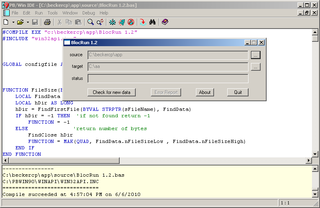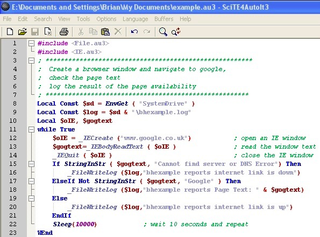
A shell script is a computer program designed to be run by a Unix shell, a command-line interpreter. The various dialects of shell scripts are considered to be scripting languages. Typical operations performed by shell scripts include file manipulation, program execution, and printing text. A script which sets up the environment, runs the program, and does any necessary cleanup or logging, is called a wrapper.
VBScript is an Active Scripting language developed by Microsoft that is modeled on Visual Basic. It allows Microsoft Windows system administrators to generate powerful tools for managing computers without error handling and with subroutines and other advanced programming constructs. It can give the user complete control over many aspects of their computing environment.
Visual DialogScript (VDS) is an interpreted programming language for Microsoft Windows. It can be used to create small and fast programs. VDS has a large number of dialog and graphic elements available to create professional-looking programs. VDS programs have access to the Windows API; therefore, it is possible to write applications that can perform the same advanced tasks as other programming languages such as Visual Basic, C++, or Delphi.

Liberty BASIC (LB) is a commercial computer programming language and integrated development environment (IDE). It has an interpreter, developed in Smalltalk, which recognizes its own dialect of the BASIC programming language. It runs on 16- and 32-bit Windows and OS/2.

PureBasic is a commercially distributed procedural computer programming language and integrated development environment based on BASIC and developed by Fantaisie Software for Windows, Linux, and macOS. An Amiga version is available, although it has been discontinued and some parts of it are released as open-source. The first public release of PureBasic for Windows was on 17 December 2000. It has been continually updated ever since.

PowerBASIC, formerly Turbo Basic, is the brand of several commercial compilers by PowerBASIC Inc. that compile a dialect of the BASIC programming language. There are both MS-DOS and Windows versions, and two kinds of the latter: Console and Windows. The MS-DOS version has a syntax similar to that of QBasic and QuickBASIC. The Windows versions use a BASIC syntax expanded to include many Windows functions, and the statements can be combined with calls to the Windows API.

The Windows API, informally WinAPI, is Microsoft's core set of application programming interfaces (APIs) available in the Microsoft Windows operating systems. The name Windows API collectively refers to several different platform implementations that are often referred to by their own names. Almost all Windows programs interact with the Windows API. On the Windows NT line of operating systems, a small number use the Native API.
AppleScript is a scripting language created by Apple Inc. that facilitates automated control over scriptable Mac applications. First introduced in System 7, it is currently included in all versions of macOS as part of a package of system automation tools. The term "AppleScript" may refer to the language itself, to an individual script written in the language, or, informally, to the macOS Open Scripting Architecture that underlies the language.

The Microsoft Windows Script Host (WSH) is an automation technology for Microsoft Windows operating systems that provides scripting abilities comparable to batch files, but with a wider range of supported features. This tool was first provided on Windows 95 after Build 950a on the installation discs as an optional installation configurable and installable by means of the Control Panel, and then a standard component of Windows 98 and subsequent and Windows NT 4.0 Build 1381 and by means of Service Pack 4. The WSH is also a means of automation for Internet Explorer via the installed WSH engines from IE Version 3.0 onwards; at this time VBScript became means of automation for Microsoft Outlook 97. The WSH is also an optional install provided with a VBScript and JScript engine for Windows CE 3.0 and following and some third-party engines including Rexx and other forms of Basic are also available.

Nullsoft Scriptable Install System (NSIS) is a script-driven installer authoring tool for Microsoft Windows backed by Nullsoft, the creators of Winamp. NSIS is released under a combination of free software licenses, primarily the zlib license. It has become a widely used alternative to commercial proprietary products like InstallShield, with users including Amazon, Dropbox, Google, Ubisoft, FL Studio, BitTorrent, and McAfee.
wxBasic is a free software / open-source software, cross-platform BASIC interpreter. As it is based on syntax of the BASIC language, it is designed to be simple to learn and understand, and allow novice programmers to write applications for graphical environments like Windows and Linux with minimal effort. wxBasic is a bytecode based language, like Perl or Java. It is licensed under the LGPL, so proprietary software's source code can be linked against it.

Command Prompt, also known as cmd.exe or cmd, is the default command-line interpreter for the OS/2, eComStation, ArcaOS, Microsoft Windows, and ReactOS operating systems. On Windows CE .NET 4.2, Windows CE 5.0 and Windows Embedded CE 6.0 it is referred to as the Command Processor Shell. Its implementations differ between operating systems, but the behavior and basic set of commands are consistent. cmd.exe is the counterpart of COMMAND.COM in DOS and Windows 9x systems, and analogous to the Unix shells used on Unix-like systems. The initial version of cmd.exe for Windows NT was developed by Therese Stowell. Windows CE 2.11 was the first embedded Windows release to support a console and a Windows CE version of cmd.exe. The ReactOS implementation of cmd.exe is derived from FreeCOM, the FreeDOS command line interpreter.color a

A command shell is a command-line interface to interact with and manipulate a computer's operating system.
In CP/M-86, Concurrent CP/M-86, Personal CP/M-86, S5-DOS, DOS Plus, Concurrent DOS, FlexOS, Multiuser DOS, System Manager and REAL/32 as well as by SCP1700, CP/K and K8918-OS, CMD is the filename extension used by CP/M-style executable programs. It corresponds to COM in CP/M-80 and EXE in DOS. The same extension is used by the command-line interpreter CMD.EXE in OS/2 and Windows for batch files.

In computing, a shell is a computer program that exposes an operating system's services to a human user or other programs. In general, operating system shells use either a command-line interface (CLI) or graphical user interface (GUI), depending on a computer's role and particular operation. It is named a shell because it is the outermost layer around the operating system.

AutoIt is a freeware programming language for Microsoft Windows. In its earliest release, it was primarily intended to create automation scripts for Microsoft Windows programs but has since grown to include enhancements in both programming language design and overall functionality.
An HTML Application (HTA) is a Microsoft Windows program whose source code consists of HTML, Dynamic HTML, and one or more scripting languages supported by Internet Explorer, such as VBScript or JScript. The HTML is used to generate the user interface, and the scripting language is used for the program logic. An HTA executes without the constraints of the internet browser security model; in fact, it executes as a "fully trusted" application.
A batch file is a script file in DOS, OS/2 and Microsoft Windows. It consists of a series of commands to be executed by the command-line interpreter, stored in a plain text file. A batch file may contain any command the interpreter accepts interactively and use constructs that enable conditional branching and looping within the batch file, such as IF, FOR, and GOTO labels. The term "batch" is from batch processing, meaning "non-interactive execution", though a batch file might not process a batch of multiple data.

A scripting language or script language is a programming language that is used to manipulate, customize, and automate the facilities of an existing system. Scripting languages are usually interpreted at runtime rather than compiled.

A command-line interface (CLI) is a means of interacting with a device or computer program with commands from a user or client, and responses from the device or program, in the form of lines of text. Such access was first provided by computer terminals starting in the mid-1960s. This provided an interactive environment not available with punched cards or other input methods.









